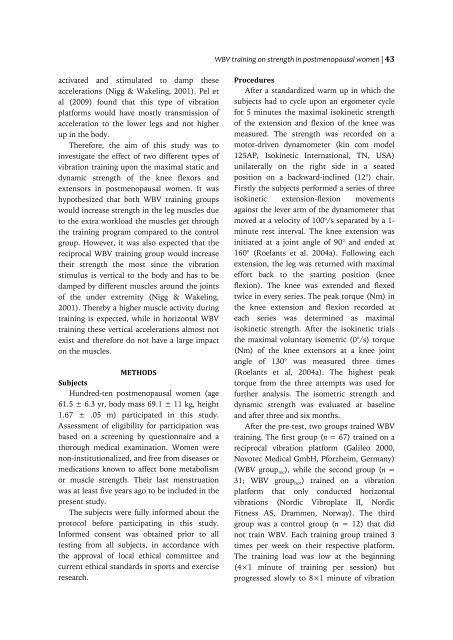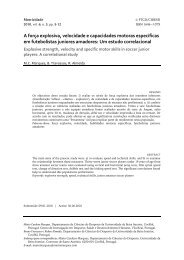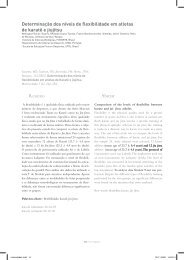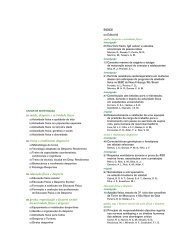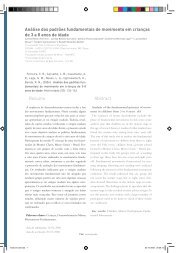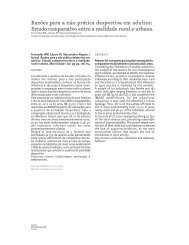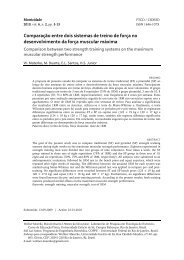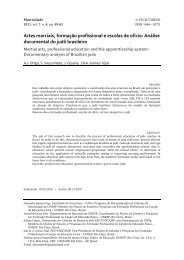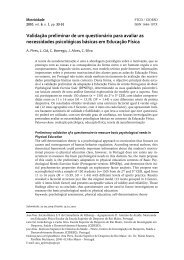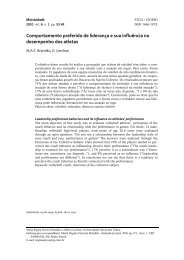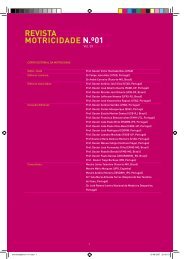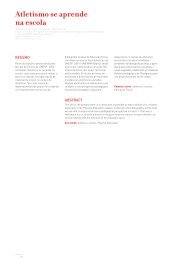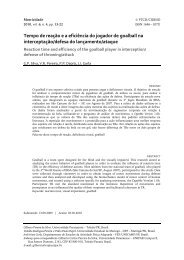revista motricidade
revista motricidade
revista motricidade
- No tags were found...
You also want an ePaper? Increase the reach of your titles
YUMPU automatically turns print PDFs into web optimized ePapers that Google loves.
WBV training on strength in postmenopausal women | 43<br />
activated and stimulated to damp these<br />
accelerations (Nigg & Wakeling, 2001). Pel et<br />
al (2009) found that this type of vibration<br />
platforms would have mostly transmission of<br />
acceleration to the lower legs and not higher<br />
up in the body.<br />
Therefore, the aim of this study was to<br />
investigate the effect of two different types of<br />
vibration training upon the maximal static and<br />
dynamic strength of the knee flexors and<br />
extensors in postmenopausal women. It was<br />
hypothesized that both WBV training groups<br />
would increase strength in the leg muscles due<br />
to the extra workload the muscles get through<br />
the training program compared to the control<br />
group. However, it was also expected that the<br />
reciprocal WBV training group would increase<br />
their strength the most since the vibration<br />
stimulus is vertical to the body and has to be<br />
damped by different muscles around the joints<br />
of the under extremity (Nigg & Wakeling,<br />
2001). Thereby a higher muscle activity during<br />
training is expected, while in horizontal WBV<br />
training these vertical accelerations almost not<br />
exist and therefore do not have a large impact<br />
on the muscles.<br />
METHODS<br />
Subjects<br />
Hundred-ten postmenopausal women (age<br />
61.5 ± 6.3 yr, body mass 69.1 ± 11 kg, height<br />
1.67 ± .05 m) participated in this study.<br />
Assessment of eligibility for participation was<br />
based on a screening by questionnaire and a<br />
thorough medical examination. Women were<br />
non-institutionalized, and free from diseases or<br />
medications known to affect bone metabolism<br />
or muscle strength. Their last menstruation<br />
was at least five years ago to be included in the<br />
present study.<br />
The subjects were fully informed about the<br />
protocol before participating in this study.<br />
Informed consent was obtained prior to all<br />
testing from all subjects, in accordance with<br />
the approval of local ethical committee and<br />
current ethical standards in sports and exercise<br />
research.<br />
Procedures<br />
After a standardized warm up in which the<br />
subjects had to cycle upon an ergometer cycle<br />
for 5 minutes the maximal isokinetic strength<br />
of the extension and flexion of the knee was<br />
measured. The strength was recorded on a<br />
motor-driven dynamometer (kin com model<br />
125AP, Isokinetic International, TN, USA)<br />
unilaterally on the right side in a seated<br />
position on a backward-inclined (12°) chair.<br />
Firstly the subjects performed a series of three<br />
isokinetic extension-flexion movements<br />
against the lever arm of the dynamometer that<br />
moved at a velocity of 100°/s separated by a 1-<br />
minute rest interval. The knee extension was<br />
initiated at a joint angle of 90° and ended at<br />
160° (Roelants et al. 2004a). Following each<br />
extension, the leg was returned with maximal<br />
effort back to the starting position (knee<br />
flexion). The knee was extended and flexed<br />
twice in every series. The peak torque (Nm) in<br />
the knee extension and flexion recorded at<br />
each series was determined as maximal<br />
isokinetic strength. After the isokinetic trials<br />
the maximal voluntary isometric (0°/s) torque<br />
(Nm) of the knee extensors at a knee joint<br />
angle of 130° was measured three times<br />
(Roelants et al, 2004a). The highest peak<br />
torque from the three attempts was used for<br />
further analysis. The isometric strength and<br />
dynamic strength was evaluated at baseline<br />
and after three and six months.<br />
After the pre-test, two groups trained WBV<br />
training. The first group (n = 67) trained on a<br />
reciprocal vibration platform (Galileo 2000,<br />
Novotec Medical GmbH, Pforzheim, Germany)<br />
(WBV group rec ), while the second group (n =<br />
31; WBV group hor ) trained on a vibration<br />
platform that only conducted horizontal<br />
vibrations (Nordic Vibroplate II, Nordic<br />
Fitness AS, Drammen, Norway). The third<br />
group was a control group (n = 12) that did<br />
not train WBV. Each training group trained 3<br />
times per week on their respective platform.<br />
The training load was low at the beginning<br />
(4×1 minute of training per session) but<br />
progressed slowly to 8×1 minute of vibration


